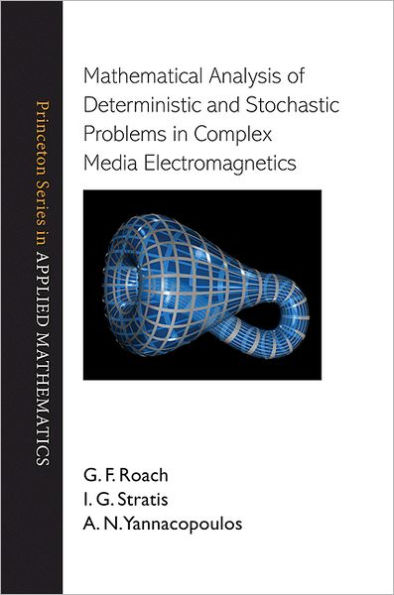
Mathematical Analysis of Deterministic and Stochastic Problems in Complex Media Electromagnetics
400
Mathematical Analysis of Deterministic and Stochastic Problems in Complex Media Electromagnetics
400Hardcover
-
PICK UP IN STORECheck Availability at Nearby Stores
Available within 2 business hours
Related collections and offers
Overview

Product Details
| ISBN-13: | 9780691142173 |
|---|---|
| Publisher: | Princeton University Press |
| Publication date: | 03/04/2012 |
| Series: | Princeton Series in Applied Mathematics , #42 |
| Pages: | 400 |
| Product dimensions: | 6.40(w) x 9.30(h) x 1.20(d) |
| Age Range: | 18 Years |
About the Author
Table of Contents
Preface xi
PART 1. MODELLING AND MATHEMATICAL PRELIMINARIES 1
Chapter 1. Complex Media 3
Chapter 2. The Maxwell Equations and Constitutive Relations 9
2.1 Introduction 9
2.2 Fundamentals 9
2.3 Constitutive relations 13
2.4 The Maxwell equations in complex media: A variety of problems 23
Chapter 3. Spaces and Operators 38
3.1 Introduction 38
3.2 Function spaces 38
3.3 Standard difierential and trace operators 45
3.4 Function spaces for electromagnetics 48
3.5 Traces 51
3.6 Various decompositions 52
3.7 Compact embeddings 53
3.8 The operators of vector analysis revisited 54
3.9 The Maxwell operator 56
PART 2. TIME-HARMONIC DETERMINISTIC PROBLEMS 59
Chapter 4. Well Posedness 61
4.1 Introduction 61
4.2 Solvability of the interior problem 62
4.3 The eigenvalue problem 68
4.4 Low chirality behaviour 70
4.5 Comments on exterior domain problems 74
4.6 Towards numerics 77
Chapter 5. Scattering Problems: Beltrami Fields and Solvability 83
5.1 Introduction 83
5.2 Elliptic, circular and linear polarisation of waves 84
5.3 Beltrami fields - The Bohren decomposition 86
5.4 Scattering problems: Formulation 88
5.5 An introduction to BIEs 91
5.6 Properties of Beltrami fields 96
5.7 Solvability 99
5.8 Generalised Muller's BIEs 106
5.9 Low chirality approximations 108
5.10 Miscellanea 109
Chapter 6. Scattering Problems: A Variety of Topics 112
6.1 Introduction 112
6.2 Important concepts of scattering theory 113
6.3 Back to chiral media: Scattering relations and the far-field operator 118
6.4 Using dyadics 124
6.5 Herglotz wave functions 129
6.6 Domain derivative 136
6.7 Miscellanea 140
PART 3. TIME-DEPENDENT DETERMINISTIC PROBLEMS 149
Chapter 7. Well Posedness 151
7.1 Introduction 151
7.2 The Maxwell equations in the time domain 151
7.3 Functional framework and assumptions 152
7.4 Solvability 153
7.5 Other possible approaches to solvability 158
7.6 Miscellanea 162
Chapter 8. Controllability 163
8.1 Introduction 163
8.2 Formulation 163
8.3 Controllability of achiral media: The Hilbert Uniqueness method 165
8.4 The forward and backward problems 167
8.5 Controllability: Complex media 174
8.6 Miscellanea 176
Chapter 9. Homogenisation 180
9.1 Introduction 180
9.2 Formulation 181
9.3 A formal two-scale expansion 184
9.4 The optical response region 188
9.5 General bianisotropic media 199
9.6 Miscellanea 207
Chapter 10. Towards a Scattering Theory 212
10.1 Introduction 212
10.2 Formulation 213
10.3 Some basic strategies 214
10.4 On the construction of solutions 217
10.5 Wave operators and their construction 220
10.6 Complex media electromagnetics 225
10.7 Miscellanea 229
Chapter 11. Nonlinear Problems 231
11.1 Introduction 231
11.2 Formulation 231
11.3 Well posedness of the model 232
11.4 Miscellanea 241
PART 4. STOCHASTIC PROBLEMS 245
Chapter 12. Well Posedness 247
12.1 Introduction 247
12.2 Maxwell equations for random media 248
12.3 Functional setting 249
12.4 Well posedness 250
12.5 Other possible approaches to solvability 255
12.6 Miscellanea 261
Chapter 13. Controllability 263
13.1 Introduction 263
13.2 Formulation 263
13.3 Subtleties of stochastic controllability 264
13.4 Approximate controllability I: Random PDEs 266
13.5 Approximate controllability II: BSPDEs 269
13.6 Miscellanea 272
Chapter 14. Homogenisation 275
14.1 Introduction 275
14.2 Ergodic media 276
14.3 Formulation 279
14.4 A formal two-scale expansion 282
14.5 Homogenisation of the Maxwell system 284
14.6 Miscellanea 288
PART 5. APPENDICES 291
Appendix A. Some Facts from Functional Analysis 293
A.1 Duality 293
A.2 Strong, weak and weak-* convergence 295
A.3 Calculus in Banach spaces 297
A.4 Basic elements of spectral theory 300
A.5 Compactness criteria 303
A.6 Compact operators 304
A.7 The Banach-Steinhaus theorem 308
A.8 Semigroups and the Cauchy problem 308
A.9 Some fixed point theorems 312
A.10 The Lax-Milgram lemma 313
A.11 Gronwall's inequality 314
A.12 Nonlinear operators 315
Appendix B. Some Facts from Stochastic Analysis 316
B.1 Probability in Hilbert spaces 316
B.2 Stochastic processes and random fields 318
B.3 Gaussian measures 319
B.4 The Q- and the cylindrical Wiener process 320
B.5 The Ito integral 321
B.6 Ito formula 324
B.7 Stochastic convolution 325
B.8 SDEs in Hilbert spaces 325
B.9 Martingale representation theorem 326
Appendix C. Some Facts from Elliptic Homogenisation Theory 327
C.1 Spaces of periodic functions 327
C.2 Compensated compactness 329
C.3 Homogenisation of elliptic equations 329
C.4 Random elliptic homogenisation theory 332
Appendix D. Some Facts from Dyadic Analysis (by George Dassios) 334
Appendix E. Notation and abbreviations 341
Bibliography 343
Index 377
What People are Saying About This
"This is an outstanding book that has the potential to become a real classic. It is the first to systematically address the mathematics of electromagnetic wave propagation in complex media. It will be useful not only to mathematicians but also graduate students, physicists, and engineers who want to get a state-of-the-art picture of scattering by complex media."—Gerhard Kristensson, Lund University, Sweden
